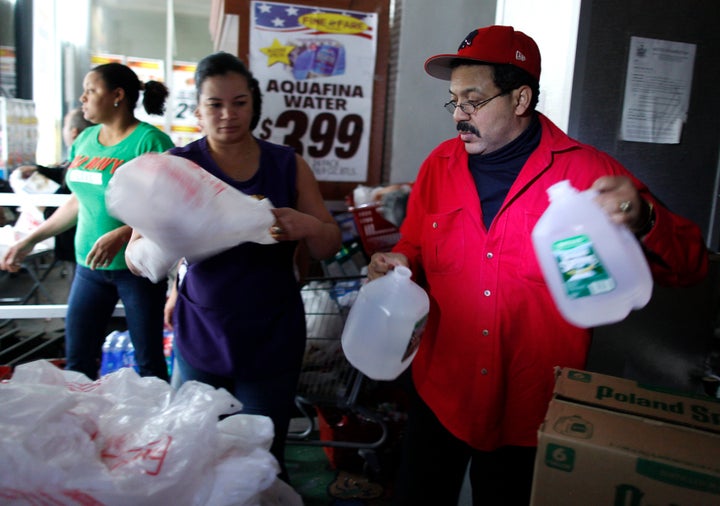 |
| WARREN FAIDLEY VIA GETTY IMAGES |
by Jeff Goodell, Huffington Post: https://www.huffingtonpost.com/entry/sea-levels-fossil-fuel_us_5ab395cee4b008c9e5f48fd9
After the hurricane hit Miami in 2037, a foot of sand covered the famous bow-tie floor in the lobby of the Fontainebleau Hotel in Miami Beach. A dead manatee floated in the pool where Elvis had once swum.
Most of the damage came not from the hurricane’s 175-mile-an-hour winds, but from the 20-foot storm surge that overwhelmed the low-lying city. In South Beach, historic Art Deco buildings were swept off their foundations. Mansions on Star Island were flooded up to their cut-glass doorknobs. A 17-mile stretch of Highway A1A that ran along the famous beaches up to Fort Lauderdale disappeared into the Atlantic.
The storm knocked out the wastewater treatment plant on Virginia Key, forcing the city to dump hundreds of millions of gallons of raw sewage into Biscayne Bay. Tampons and condoms littered the beaches, and the stench of human excrement stoked fears of cholera.
More than 300 people died, many of them swept away by the surging waters that submerged much of Miami Beach and Fort Lauderdale; 13 people were killed in traffic accidents as they scrambled to escape the city after the news spread — falsely, it turned out — that one of the nuclear reactors at Turkey Point, an aging power plant 24 miles south of Miami, had been heavily damaged by the surge and had sent a radioactive cloud floating over the city.
The president, of course, said that Americans did not give up, that the city would be rebuilt better and stronger than it had been before. But it was clear to those not fooling themselves that this storm was the beginning of the end of Miami as a booming 21st-century city.
This is, of course, merely one possible vision of the future. There are brighter ways to imagine it — and darker ways. But I am a journalist, not a Hollywood screenwriter. I want to tell a true story about the future we are creating for ourselves.
It begins with this: The climate is warming, the world’s great ice sheets are melting, and the water is rising.
This is not a speculative idea, or the hypothesis of a few wacky scientists, or a hoax perpetrated by the Chinese. Sea-level rise is one of the central facts of our time, as real as gravity. It will reshape our world in ways most of us can only dimly imagine.
My own interest in this story began with an actual hurricane. Shortly after Hurricane Sandy hit New York City in 2012, I visited the Lower East Side of Manhattan, one of the neighborhoods that had been hardest hit by flooding from the storm. The water had receded by the time I arrived, but the neighborhood already smelled of mold and rot. The power was out; the shops were closed. I saw broken trees, abandoned cars, debris scattered everywhere, people hauling ruined furniture out of basement apartments. I have been writing about climate change for more than a decade, but seeing the flooding on the Lower East Side made it visceral for me.

In the 20th century, the oceans rose nearly 6 inches. But that was before the heat from burning fossil fuels had much impact on Greenland and Antarctica. Today, seas are rising at more than twice the rate they did in the last century. As warming of the Earth increases and the ice sheets begin to feel the heat, the rate of sea-level rise is likely to increase rapidly.
A 2017 report by the National Oceanic and Atmospheric Association, the United States’ top climate science agency, says global sea-level rise could range from about 1 foot to more than 8 feet by 2100. Depending on how much we heat up the planet, it will continue rising for centuries after that.
Although there is still some uncertainty about these forecasts, many scientists I’ve talked to now believe that the high-end projections are likely to increase as they get a better understanding of ice dynamics. Temperature-wise, the trend lines are rising: 2016 was the hottest year on record, and as I’m writing this, the Arctic is more than 45 degrees Fahrenheit warmer than normal.
But if you live on the coast, what matters more than the height of sea rises is the rate at which they rise. If the water rises slowly, people will have time to elevate roads and buildings and build seawalls. Or move away. It is likely to be disruptive but manageable.
Unfortunately, Mother Nature is not always so docile. In the past, the seas have risen in dramatic pulses that coincide with the sudden collapse of ice sheets. After the end of the last ice age, there is evidence that the water rose about 13 feet in a single century. If that were to occur again, it would be a catastrophe for coastal cities around the world.
The best way to save coastal cities is to quit burning fossil fuels. But even if we ban coal, gas and oil tomorrow, we won’t be able to turn down the Earth’s thermostat immediately. For one thing, carbon dioxide is not like other kinds of air pollution, such as the chemicals that cause smog, which go away as soon as you stop dumping them into the sky. A good fraction of the carbon dioxide emitted today will stay in the atmosphere for thousands of years.
Even if we replaced every SUV on the planet with a skateboard and every coal plant with solar panels and could magically reduce global carbon pollution to zero by tomorrow, because of the heat that has already built up in the atmosphere and the oceans, the seas would not stop rising — at least until the Earth cooled off, which could take centuries.
This doesn’t mean that cutting carbon dioxide is pointless. On the contrary. If we can hold the warming to about 3 degrees Fahrenheit above pre-industrial temperatures, we might only face 2 feet of sea-level rise this century, giving people more time to adapt. However, if we don’t end the fossil fuel party, we’re headed for more than 8 degrees Fahrenheit of warming — and with that, all bets are off.

We could get 4 feet of sea-level rise by the end of the century — or we could get 13 feet. If we burn all the known reserves of coal, oil and gas on the planet, seas will likely rise by more than 200 feet in the coming centuries, submerging virtually every major coastal city in the world.
The rise will make itself felt in higher storm surges, higher tides, and a gradual washing away of beaches, of roads, of coastal infrastructure. Even in the worst-case scenarios, the changes will occur over years, decades and centuries.
It’s exactly the kind of threat that we humans are genetically ill-equipped to deal with. We have evolved to defend ourselves from a guy with a knife or an animal with big teeth, but we are not wired to make decisions about barely perceptible threats that gradually accelerate over time.
One of the hard truths about sea-level rise is that rich cities and nations can afford to build seawalls, upgrade sewage systems and elevate critical infrastructure. Poor cities and nations cannot. But even for rich countries, the economic losses will be high. One recent study estimated that with 6 feet of sea-level rise, nearly $1 trillion worth of real estate in the U.S. will be underwater, including 1 in 8 homes in Florida.
But it is not just money that will be lost. Also gone will be the beach where you had your first kiss; the mangrove forests in Bangladesh where Bengali tigers thrive; St. Mark’s Basilica in Venice, Italy; NASA’s Kennedy Space Center; the slums of Jakarta, Indonesia; entire nations like the Maldives; and, in the not-so-distant future, Mar-a-Lago, the winter White House of President Donald Trump.
About 145 million people live 3 feet or less above the current sea level. As the waters rise, millions of these people will be displaced, many of them in poor countries, creating generations of climate refugees that will make today’s Syrian war refugee crisis look like a high school drama production.
The real issue here is the complexity of human psychology. At what point will we take dramatic action to cut carbon dioxide pollution? Will we spend billions on adaptive infrastructure to prepare cities for rising waters — or will we do nothing until it is too late? Will we welcome people who flee submerged coastlines and sinking islands — or will we imprison them? No one knows how our economic and political system will deal with these challenges.
The simple truth is, human beings have become a geological force on the planet, with the power to reshape the boundaries of the world in ways we didn’t intend and don’t entirely understand. Every day, little by little, the water is rising, washing away beaches, eroding coastlines, pushing into homes and shops and places of worship. As our world floods, it is likely to cause immense suffering and devastation. It is also likely to bring people together and inspire creativity and camaraderie in ways no one can foresee. Either way, the water is coming.
CORRECTION: A previous version of this story called Mar-a-Lago the summer White House. It is known as the winter White House.
This excerpt has been adapted from The Water Will Come: Rising Seas, Sinking Cities and the Remaking of the Civilized World, published by Black Inc. (£17.99 / AU$34.99) and in the U.S. by Little, Brown ($28.99).
No comments:
Post a Comment